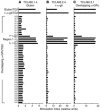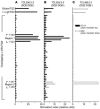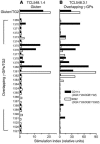HLA-DQ2 and -DQ8 signatures of gluten T cell epitopes in celiac disease
- PMID: 16878175
- PMCID: PMC1518792
- DOI: 10.1172/JCI27620
HLA-DQ2 and -DQ8 signatures of gluten T cell epitopes in celiac disease
Abstract
Celiac disease is associated with HLA-DQ2 and, to a lesser extent, HLA-DQ8. Type 1 diabetes is associated with the same DQ molecules in the opposite order and with possible involvement of trans-encoded DQ heterodimers. T cells that are reactive with gluten peptides deamidated by transglutaminase 2 and invariably restricted by DQ2 or DQ8 can be isolated from celiac lesions. We used intestinal T cells from celiac patients to map DQ2 and DQ8 epitopes within 2 representative gluten proteins, alpha-gliadin AJ133612 and gamma-gliadin M36999. For alpha-gliadin, DQ2- and DQ8-restricted T cells recognized deamidated peptides of 2 separate regions. For gamma-gliadin, DQ2- and DQ8-restricted T cells recognized deamidated peptides of the same region. Some gamma-gliadin peptides were recognized by T cells in the context of DQ2 or DQ8 when bound in exactly the same registers, but with different requirements for deamidation; deamidation at peptide position 4 (P4) was important for DQ2-restricted T cells, whereas deamidation at P1 and/or P9 was important for DQ8-restricted T cells. Peptides combining the DQ2 and DQ8 signatures could be presented by DQ2, DQ8, and trans-encoded DQ heterodimers. Our findings shed light on the basis for the HLA associations in celiac disease and type 1 diabetes.
Figures







Similar articles
-
Refining the rules of gliadin T cell epitope binding to the disease-associated DQ2 molecule in celiac disease: importance of proline spacing and glutamine deamidation.J Immunol. 2005 Jul 1;175(1):254-61. doi: 10.4049/jimmunol.175.1.254. J Immunol. 2005. PMID: 15972656
-
Structure of celiac disease-associated HLA-DQ8 and non-associated HLA-DQ9 alleles in complex with two disease-specific epitopes.Int Immunol. 2000 Aug;12(8):1157-66. doi: 10.1093/intimm/12.8.1157. Int Immunol. 2000. PMID: 10917890
-
The intestinal T cell response to alpha-gliadin in adult celiac disease is focused on a single deamidated glutamine targeted by tissue transglutaminase.J Exp Med. 2000 Feb 21;191(4):603-12. doi: 10.1084/jem.191.4.603. J Exp Med. 2000. PMID: 10684852 Free PMC article.
-
Celiac disease: how complicated can it get?Immunogenetics. 2010 Oct;62(10):641-51. doi: 10.1007/s00251-010-0465-9. Epub 2010 Jul 27. Immunogenetics. 2010. PMID: 20661732 Free PMC article. Review.
-
Pathomechanisms in celiac disease.Int Arch Allergy Immunol. 2003 Oct;132(2):98-108. doi: 10.1159/000073710. Int Arch Allergy Immunol. 2003. PMID: 14600421 Review.
Cited by
-
Targeted modification of wheat grain protein to reduce the content of celiac causing epitopes.Funct Integr Genomics. 2012 Aug;12(3):417-38. doi: 10.1007/s10142-012-0287-y. Epub 2012 Jun 26. Funct Integr Genomics. 2012. PMID: 22732824 Review.
-
Gamma-gliadin specific celiac disease antibodies recognize p31-43 and p57-68 alpha gliadin peptides in deamidation related manner as a result of cross-reaction.Amino Acids. 2021 Jul;53(7):1051-1063. doi: 10.1007/s00726-021-03006-7. Epub 2021 May 31. Amino Acids. 2021. PMID: 34059947 Free PMC article.
-
Maize prolamins resistant to peptic-tryptic digestion maintain immune-recognition by IgA from some celiac disease patients.Plant Foods Hum Nutr. 2012 Mar;67(1):24, 30. doi: 10.1007/s11130-012-0274-4. Plant Foods Hum Nutr. 2012. PMID: 22298027
-
Gliadin peptide P31-43 localises to endocytic vesicles and interferes with their maturation.PLoS One. 2010 Aug 18;5(8):e12246. doi: 10.1371/journal.pone.0012246. PLoS One. 2010. PMID: 20805894 Free PMC article.
-
A molecular basis for the T cell response in HLA-DQ2.2 mediated celiac disease.Proc Natl Acad Sci U S A. 2020 Feb 11;117(6):3063-3073. doi: 10.1073/pnas.1914308117. Epub 2020 Jan 23. Proc Natl Acad Sci U S A. 2020. PMID: 31974305 Free PMC article.
References
-
- Green P.H., Jabri B. Coeliac disease. Lancet. 2003;362:383–391. - PubMed
-
- Sollid L.M. Molecular basis of celiac disease. Annu. Rev. Immunol. 2000;18:53–81. - PubMed
-
- Sollid L.M., Lie B.A. Celiac disease genetics: current concepts and practical applications. . Clin. Gastroenterol. Hepatol. 2005;3:843–851. - PubMed
-
- Molberg Ø., et al. Gliadin specific, HLA DQ2-restricted T cells are commonly found in small intestinal biopsies from coeliac disease patients, but not from controls. Scand. J. Immunol. 1997;46:103–109. - PubMed
Publication types
MeSH terms
Substances
LinkOut - more resources
Full Text Sources
Other Literature Sources
Medical
Research Materials

